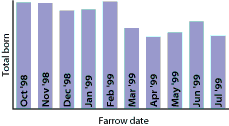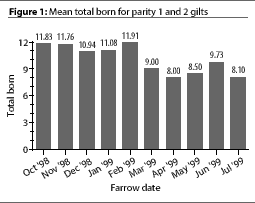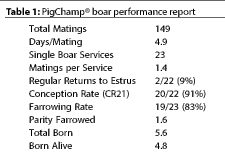WHAT'S YOUR INTERPRETATION?

Parity 1 and 2 sows experienced a sudden reduction in total born but relatively minor farrowing or conception rate changes starting in March of 1999. What could have been possible causes?
In October 1999, the owner of a 300-sow farrow-to-finish operation with an off-site finisher complex called to complain about a reduction of three piglets in total-born litter size in parity-one and parity-two litters. Other parities were not affected. There did not appear to be a significant reduction in conception or farrowing rates.
Time plots in PigCHAMP(R) Database Applications can be very useful for examining changes in productivity over time. The graph in Figure 1 shows a marked reduction of total born litter size in parity 1 and 2 sows, starting in March 1999.

Gilt factors contributing to poor performance were investigated. PigCHAMP(R) records revealed a predominance of double matings, suggestive of good quality matings with satisfactory intensity and duration of heats. Lighting intensity and photoperiod had not changed (approximately 14 hours of light). Gilt feed consumption was estimated at 3-3.5 kg right up until breeding. Postbreeding management consisted of stall housing throughout gestation and feed reduction for the first 30 days postbreeding. Acclimation of new gilts was also thought to be satisfactory but did not entail an isolation barn. There was no evidence of infectious disease.
Further investigation and review of the records revealed that a new young boar had entered the herd in early October 1998 and was used shortly after arrival to breed only smaller, younger females (gilts and parity-one sows). The Boar Performance Report is shown in Table 1. Note that conception and farrowing rates were satisfactory (91% and 83% respectively), but total born and born alive were only 5.6 and 4.8 respectively. Therefore, this boar had normal fertility but was hypoprolific. No semen analysis was performed.

It has been observed that 50% of all boars removed from a breeding herd for poor reproductive performance, expressed mainly as small litter size, carry a reciprocal translocation on autosomes.1 Boars with these chromosomal rearrangements usually demonstrated normal body conformation, sexual behavior, and semen analysis, but had decreased litter sizes.
Unfortunately, when the boar in this case was tested via chromosome karyotyping and G-banding analysis on whole blood, the cause of the hypoprolificacy could not be definitively determined. The boar was culled, and litter sizes returned to normal over the next several months.
It has become increasingly evident that litter size may be impaired while farrowing rate remains normal. We may be observing this trend as artificial insemination (AI) has become widely used and reproductive performance of boars can be assessed. With natural matings, these observations would be more difficult. It may be that the only valid tests of semen quality are farrowing rates and litter sizes. The current assessment, i.e., semen motility, morphology, etc., is crude at best. In France (and perhaps Sweden), purebred AI boars are tested cytogenetically before the semen is used for breeding. Our current procedures in the United States and Canada appear to be "primitive" (Glen Almond, personal communication, 2000).
Reference-refereed
Makinen A, Andersson A, Hakkinen A, Kuosmanen S. A reciprocal translocation between autosome 8 and 10 in a boar used for artificial insemination service and its effects on litter size. Anim Reprod Sci. 1999; 56:237-243.
--Paul Morris, DVM
MacDougald and Morris, Wellesley, Ontario.
Email: paul_morris@compuserve.com
